ASUS PB278Q Review: An IPS Competitor Emerges
by Chris Heinonen on November 19, 2012 11:00 PM ESTASUS PB278Q Color Quality
The PB278Q ships with an sRGB preset in the display, but unlike the ProArt line this doesn’t come with a guarantee of a DeltaE < 5 for color quality. Since the ProArt DeltaE didn’t meet that standard in my testing (and I don’t have enough details to know what color points they are even testing to get that number), this was a fine change by me. Compared to all the other preset modes, sRGB was by far the most accurate, so I used it for our uncalibrated, 200 nits profile testing.
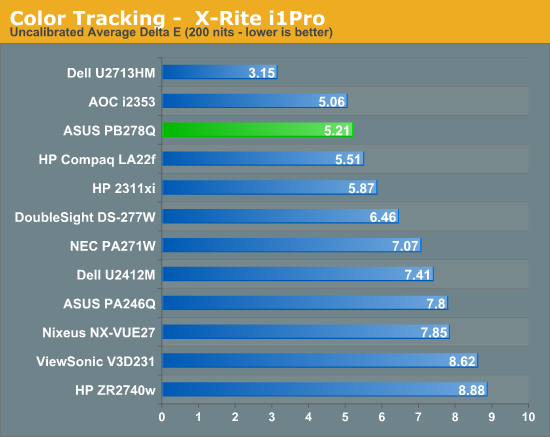
Our average uncalibrated dE is 5.21, which is actually very good for a 27” display right out of the box. You will notice that some 27” displays that were tested prior to my taking over display testing, like the Dell U2711, are not here in the graphs. This is intentional as those were tested with a different combination of hardware that can produce results that look better than they actually are. All of the displays in this chart now are measured using an i1Pro for every measurement except for black level, which an i1DisplayPro is used because of its more accurate low light readings.
Moving past that, the sRGB mode isn’t incredibly accurate in comparison to the recently reviewed Dell U2713HM display, but it is better than every other 27” display I have put onto the bench.
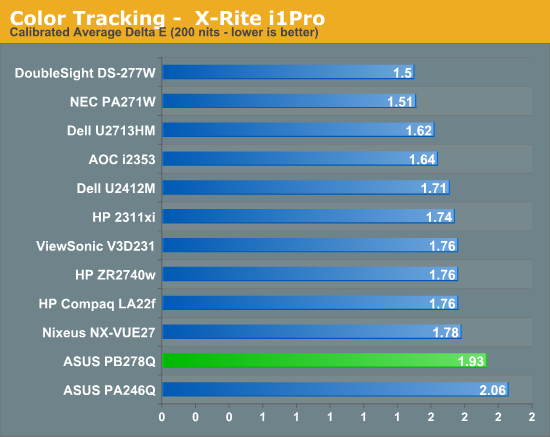
After calibration the PB278Q improved but not as much as some of the other displays have. What is really throwing this off is one shade of blue that has a dE over 6, which pulls that average up. Looking at the median error we still see a worse result than the other 27” displays out there and a grayscale that has a higher dE across the board than the other displays. This is getting picky, since all of these dE values mean that you probably won’t see any difference between the displays, even side by side, but it still doesn’t perform quite as well after calibration.
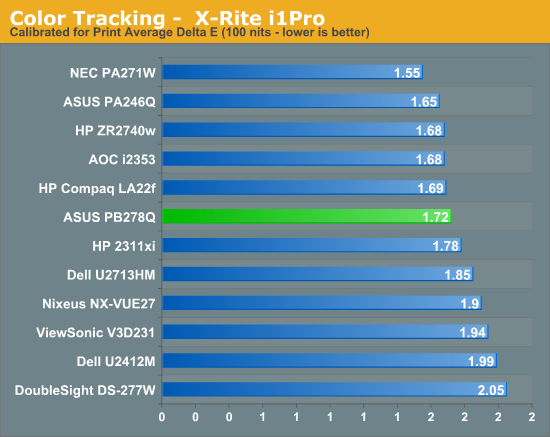
With the brightness range of the PB278Q it was easy to get the ASUS down to 100 nits for our print calibration testing without having to manipulate the LUT to do so. Here we see a bit of an improvement over the 200 nits numbers, and we manage to do better than the other 27” displays we have tested. The NEC is still the leader for low light image quality, but the ASUS is right behind it and would do a good job for those that need to do print work at lower light levels.
The color gamut on the PB278Q is going to be limited to sRGB due to the use of an LED backlighting system that uses while LEDs, and we see it has 79% of the AdobeRGB gamut available. There's nothing at all surprising or different about this; it's exactly what we expected to see.

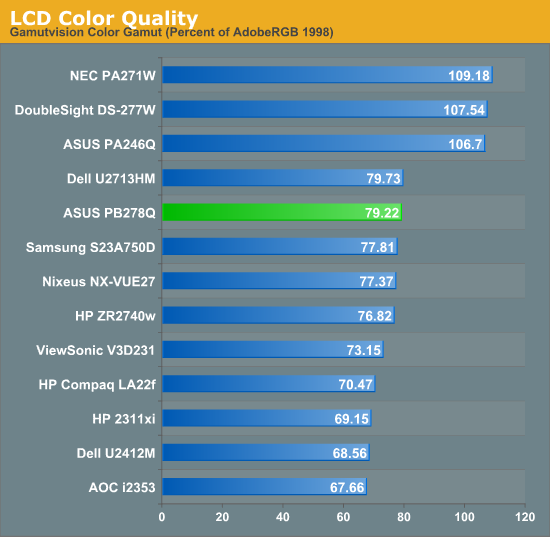
Overall the PB278Q does a pretty good job on the color quality testing. The default sRGB mode is better than most and will be good enough for those that want to have more accurate colors but aren’t willing to pay a premium for the hardware to do a full calibration. The 200 nits calibrated numbers are a little worse than I had hoped, but they are so close to others you likely won’t be able to tell at all, and the 100 nits numbers are very good.


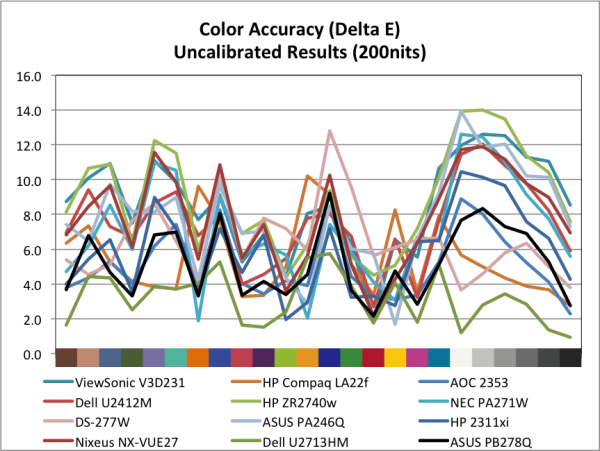
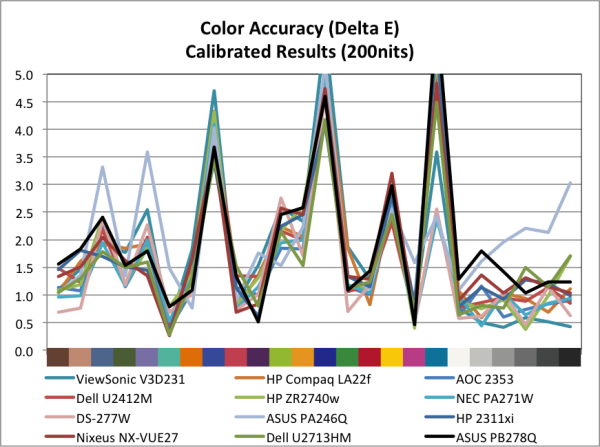
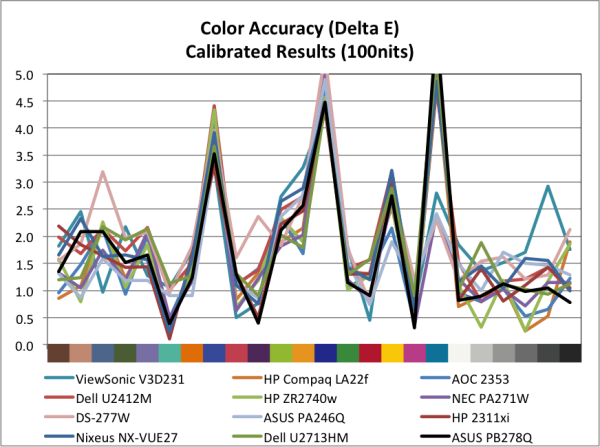








55 Comments
View All Comments
lemonadesoda - Tuesday, November 20, 2012 - link
Comparing input lag across the various inputs: DSub, DisplayPort, HDMI, and DVI inputs. If you suspect the multi-input board is causing an issue, is one input better/faster than the other? We often compare colour quality across Dsub and DVI, but let's check input lag, esp. DVI vs. Displayport.cheinonen - Tuesday, November 20, 2012 - link
I tested DVI, HDMI and DisplayPort and was getting results within 1ms of each other so it wasn't the selected input causing the issue, but the hardware controlling the inputs it seems.Crocography - Tuesday, November 20, 2012 - link
I always end up buying a Dell. Their monitors are just superb. Whether a cheap one for gaming or a great one for colour ediitng, the Dell monitors have great value. It is funny I always end up looking at all the tech out there and then I come back and buying one from Dell.While I was reading this review I was wondering if it was going to be better and cheaper than my Dell 27"... maybe some new competition, after all ASUS make great stuff. But no.
BTW, you can always find discounts on Dell monitors if you don't have to buy them right away. I have always managed to get mine on huge discounts. Gotta love it!
Cannyone - Wednesday, November 21, 2012 - link
As luck would have it I had the horizontal sync chip in my trusty 1920x1200 Hanns-G 28" go out on Monday. So I needed a new display. The catch was that I wanted a higher resolution than a 1080P monitor. And this Asus seemed like the best compromise between resolution and price. We'll see how good it really is shortly...5150Joker - Monday, March 11, 2013 - link
ViewSonic VP2770 is better than this and the Dell U2713HM.